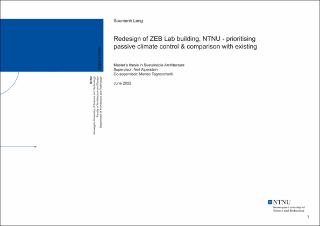| dc.description.abstract | Greenhouse gas emissions are by far the most critical concern of our era, and the building and construction sector plays a significant role in this regard. SINTEF and the Norwegian University of Science and Technology (NTNU) have been working on this matter for a long time, and they just obtained an entirely new arena for investigating and testing innovative solutions in real life which is well known as “ZEB Laboratory”. The ZEB Laboratory is possibly the only one of its kind to obtain the environmental goal of ZEB-COM with the support of active strategies and passive strategies in the design. It is important to noticed that the active solutions were the main focus points and even surpass the passive solutions in this building design’s strategies. According to that matter, therefore this thesis aims to re-develop an alternative design of ZEB Laboratory building with the goal of reaching the same environmental goal (ZEB-COM) as close as possible with passive control strategies being the foremost priority in design yet without excluding mechanical strategies based on the identical user brief, function, location, site boundary, regulation, construction material, energy efficiency strategies and energy supplies; but with a slight difference in building’s footprint.
The methodologies for this study include a literature review on the original ZEB Laboratory building and its strategies used as well as passive strategies to achieve ZEB-COM; architectural and environmental analysis of original building and the new alternative design; computerized simulations; LCA and ZEB Balance calculation with limitation for evaluation and verification of the setup goal.
By a foremost prioritized of passive strategies of maximizing solar heat gain with optimal orientation, optimal building form, optimal building envelope design and maximization of daylight condition, the total annual energy consumption of the building in the operational stage dramatically decreases compare to the existing building due to the lower energy demand for room heating and lighting in the building. With the supportive of the active strategies such as PV production and energy efficiency strategies and supplier, the new alternative ZEB building could possibly reach the ZEB-COM goal with the lower value of ZEB balance comparing to the original building.
These results of this alternative design with the main focus point of passive solar heat gain would suggest that in order to reach the ZEB-COM level, the building does need to focus both the passive and active strategies, for example, design with solar heat adpative form and maximize the PV production by having the optimal slanted roof. However, it is essential to prioritize and passively minimize the total energy consumption in the building in the initial phase. Then, the active strategies will play an important role in the remained energy consumption. | |
